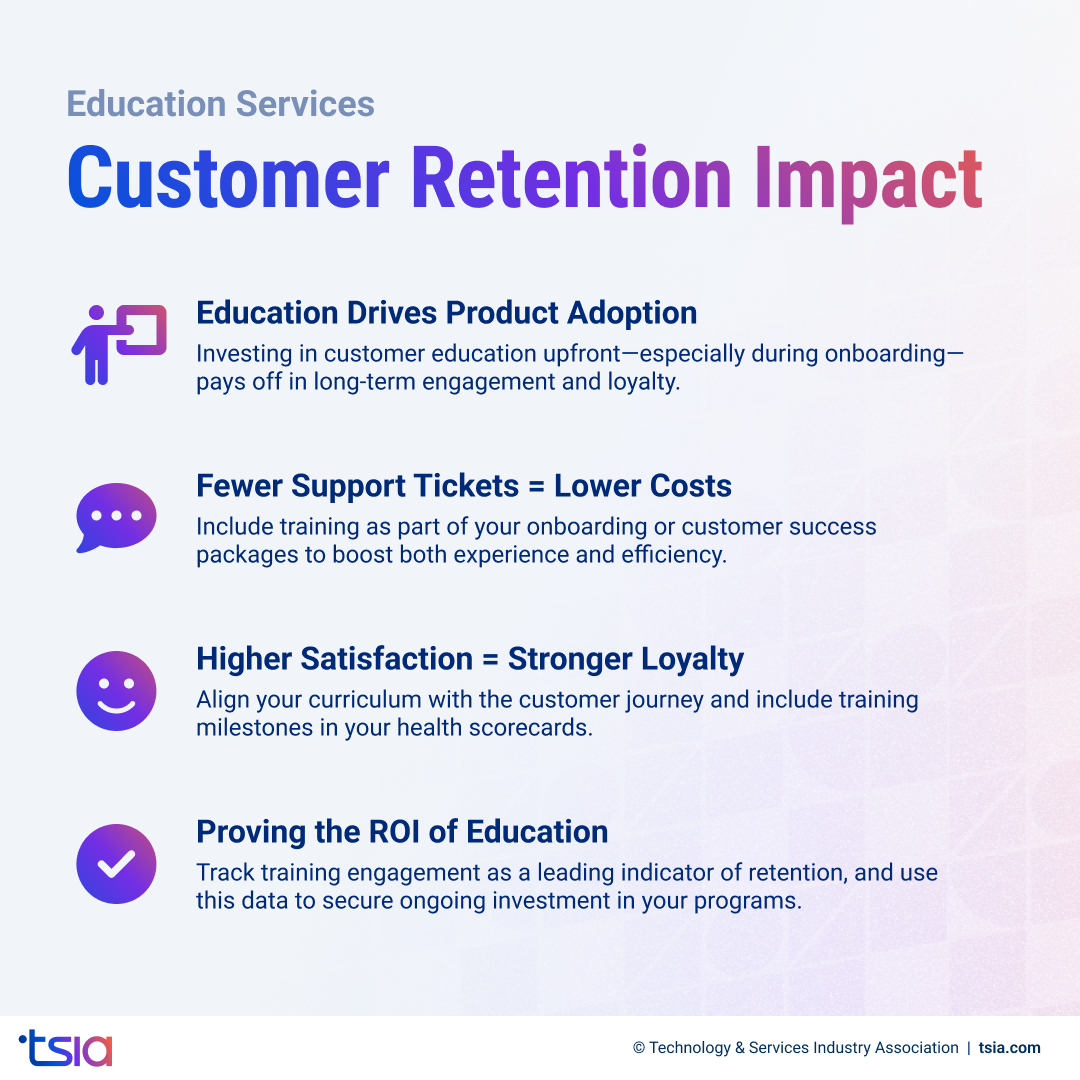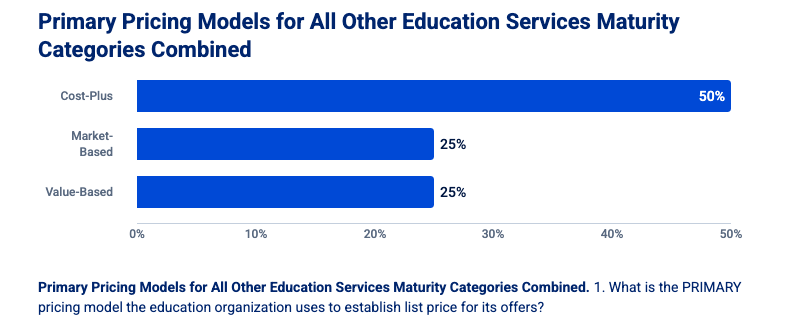As the role of education services continues to evolve, leaders across the industry are asking important, strategic questions: How does training impact retention? Which pricing models are most effective? How can we better forecast revenue?
This blog highlights the top questions education services professionals are bringing to TSIA Intelligence—and the data-backed insights they’re getting in return. Whether you're leading a training organization or looking to strengthen your impact on business outcomes (or training outcomes), you’ll find practical answers to help guide your decisions and accelerate your strategy.
Key Takeaways:
- Customer education drives retention. Well-structured training increases product adoption, satisfaction, and long-term loyalty.
- Pricing models are shifting. While cost-plus pricing remains standard, value-based and outcome-based pricing are gaining traction in the education services sector.
- Accurate forecasting is essential. Using historical data, structured methods, and the right analytics tools or predictive AI models helps you forecast revenue and align strategy with confidence.
How Does Education Services Impact Customer Retention?
If you're looking for new ways to improve customer retention, your education services program may be one of your most powerful tools. Well-structured training doesn’t just help your customers learn how to use your products—it keeps them engaged, satisfied, and coming back for more. Here’s how education services directly support retention.
Education Drives Product Adoption
When your customers understand how to use your products effectively, they’re far more likely to fully adopt them. That drives faster time-to-value (TtV), stronger satisfaction, and ultimately, higher renewal rates. Customers who consume more educational content are significantly more likely to renew than those who don’t.
What this means for you: Investing in customer education upfront—especially during onboarding—pays off in long-term engagement and loyalty.
Fewer Support Tickets = Lower Costs
Training doesn’t just help your customers—it helps your support teams, too. By proactively answering common, “how do I use this?” questions through onboarding and ongoing training, you can dramatically reduce support ticket volume. That means your customers face fewer frustrations, and your internal teams spend less time on repeat issues.
Tip: Include training as part of your onboarding or customer success packages to boost both experience and efficiency.
Higher Satisfaction = Stronger Loyalty
Education is a direct path to customer satisfaction. When customers feel confident in using your product—and see how it helps them achieve their goals—they’re more likely to report higher satisfaction scores. Companies that prioritize training often achieve stronger CSAT and NPS results, as well as increased customer loyalty.
Personalization Increases Retention
Not all learners—and customers—are the same. When you personalize your training programs based on customer roles, use cases, or business objectives, your customers feel seen and supported. That sense of being valued can make a significant difference when renewal time arrives.
Actionable idea: Align your curriculum with the customer journey and include training milestones in your health scorecards.
Proving the ROI of Education
If you can measure the correlation between training and renewals, you can prove the value of your education program. Many organizations have already established a clear connection between learning content consumption and improved renewal rates.
Your next step: Track training engagement as a leading indicator of retention, and use this data to secure ongoing investment in your programs.
The link between education services and customer retention is clear. The more value your customers get from your training, the more likely they are to adopt your product, stay satisfied, and renew. If you’re not already treating education as a core part of your retention strategy, now’s the time.
Related: The State of Education Services 2025

What Pricing Models Are Most Common in Education Services?
If you're responsible for setting prices in your education services organization, you're not alone in wondering which pricing strategies are most widely used—and which ones are worth considering as the market evolves. Here’s a breakdown of the four most common pricing models in education services today, according to data from TSIA Intelligence.
Cost-Plus Pricing (Most Common)
This traditional pricing model begins with your internal costs—such as content development, instructor time & delivery, platforms, and tools—and then adds a margin for profit. Approximately 50% of established educational organizations utilize this approach as their primary pricing model.
Why it’s popular:
- It’s simple to calculate.
- It ensures all costs are covered.
- It gives your team a predictable way to price.
However, cost-plus pricing doesn’t always reflect the actual value your services deliver to learners or organizations, which can limit your ability to scale revenue.
Market-Based Pricing
Approximately 25% of established organizations employ market-based pricing, where prices are determined based on what similar training programs charge.
Why use it:
- It helps you stay competitive in a crowded market.
- It’s easy to benchmark against industry peers.
The downside? You may end up in a pricing race to the bottom if you're only focused on matching competitors without showcasing your unique value.
Value-Based Pricing
Only about 25% of organizations have adopted this model as their primary pricing strategy, but it’s gaining traction. With value-based pricing, you set your price based on the perceived value your training provides to customers.
Why consider it:
- It aligns pricing with customer outcomes.
- It can drive higher margins when done well.
- It reinforces the strategic importance of education services.
This approach requires a deeper understanding of your customers and a stronger connection between training and business results—but positions you for long-term success.
Outcome-Based Pricing (Still Emerging)
A small number of organizations are experimenting with outcome-based pricing, which ties the price to specific business outcomes achieved through training.
Why it matters:
- It’s highly customer-centric.
- It aligns your success with theirs.
While still rare, this model could be the future of pricing as more companies prioritize measurable results over content delivery.

While the cost-plus model remains the dominant approach, the industry is gradually shifting toward value-based and outcome-based pricing to better meet evolving customer expectations and differentiate offerings in a competitive market.
Related: From Cost Center to Value Driver: The New ES Reality
How Do You Forecast Revenue for Education Services?
If you're managing an education services organization, accurate revenue forecasting is critical. Not just for financial planning, but also for setting team goals and future innovations. A reliable forecast gives you a clear picture of what’s ahead and helps you make smarter business decisions. Here’s how to establish a robust forecasting process for educational services.
Why Accurate Forecasting Matters
Forecasting isn’t just about numbers—it’s about trust. When your forecasts are accurate:
- You set realistic performance expectations across your organization.
- You align compensation plans with achievable outcomes.
- You avoid the risks of overcommitting or underinvesting in key areas.
A strong forecast supports both your team’s morale and your company’s financial health.
Start With Historical Data
Your past performance is one of the best predictors of future revenue. Be sure to:
- Analyze historical renewal rates, revenue trends, and customer behavior patterns.
- Identify seasonality and subscription cycles in the uptake of your education services.
- Benchmark your performance against industry peers to see how you stack up.
If you’re not using past data as the backbone of your forecast, you’re flying blind.
Use a Structured Forecasting Method
Rather than relying on gut feel, implement a consistent approach to forecasting. This should include:
- Renewal rate projections: For example, if your current renewal rate is 60%, expect about 60% of your current subscriptions to renew—unless you’re actively changing engagement or pricing strategies.
- Revenue recognition models: Clearly define when and how you recognize revenue. This varies depending on whether you recognize revenue at a global or regional level.
Structure creates clarity. And clarity helps leadership make confident decisions.
Factor in External Conditions
Don’t forget to zoom out and consider:
- Market trends: For example, are you moving to subscription-based education offers? That can shift revenue timing and predictability.
- Economic environment: Customer budgets, regional economic changes, and global trends can all impact your revenue outlook.
Monitoring these outside forces can help you avoid being caught off guard by unexpected changes.
Review and Refine Regularly
Forecasting is not a one-and-done process. Make it a habit to:
- Compare forecasts against actual results regularly.
- Adjust your projections based on real-time data and new insights.
- Get feedback from your customer-facing teams to understand what’s changing in the field.
Regular refinement improves accuracy and earns more trust from leadership.
Use the Right Tools
Technology can make this entire process easier and more accurate. Forecasting tools allow you to:
- Integrate data from across departments.
- Visualize revenue trends.
- Automate updates and reduce manual errors.
If your current forecasting relies solely on spreadsheets, consider upgrading to a more robust platform.
Forecasting revenue in education services requires more than just guesswork. With the correct data, structure, and tools, you can confidently predict renewals, track performance, and align your business strategy with reality. That’s what keeps your organization growing—and your leadership aligned.
Related: TSIA Education Services Benchmarking
Use Data-Driven Insights To Strengthen Your Education Services Strategy
As the questions above show, the role of education services is more strategic than ever. Whether you're fine-tuning your pricing model, looking to improve retention, or building more accurate revenue forecasts, your decisions have a direct impact on customer value and business growth.
By tapping into insights like those surfaced through TSIA Intelligence, you can gain a deeper understanding of what your peers are prioritizing—and how your organization can stay ahead. From aligning training with customer success to rethinking how you measure outcomes, education services leaders like you are shifting from support roles to strategic drivers of impact.
Frequently Asked Questions
How can education services directly impact customer retention?
When customers understand how to use your products effectively through structured training, they’re more likely to adopt your solution fully, stay satisfied, and renew, making education a powerful tool for retention.
What is TSIA Intelligence, and how can it help my team?
TSIA Intelligence enables tech services professionals to pose fundamental questions and challenges across the tech industry, providing data-backed answers and insights to help you make informed decisions faster.
How does the Performance Optimizer support leaders in education services?
TSIA’s Performance Optimizer lets you benchmark your organization against industry peers, identify capability gaps, and prioritize initiatives for growth—all based on proven best practices and data.
Smart Tip: Embrace Data-Driven Decision Making
Making smart, informed decisions is more crucial than ever. Leveraging TSIA’s in-depth insights and data-driven frameworks can help you navigate industry shifts confidently. Remember, in a world driven by artificial intelligence and digital transformation, the key to sustained success lies in making strategic decisions informed by reliable data, ensuring your role as a leader in your industry.









.png)





